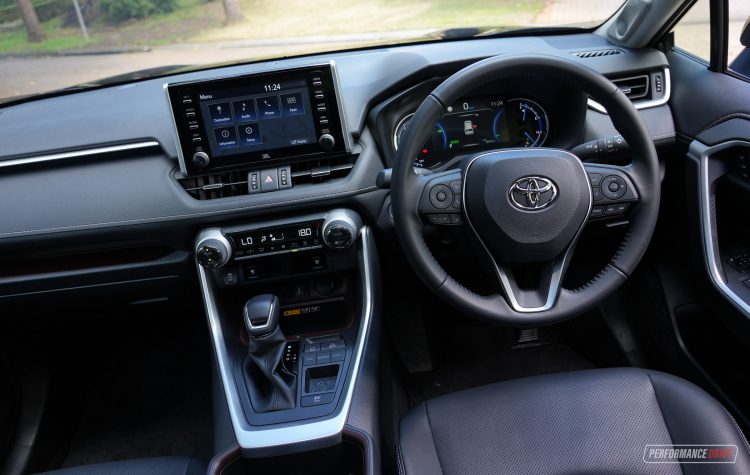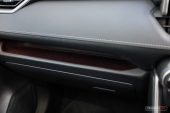When the original Toyota RAV4 was launched in 1994, it was one of the first SUVs to be designed for everyday use. Fast forward to 2022 and the RAV4 is now the most popular SUV on sale in Australia.
One of the biggest hurdles faced by customers at the moment are the delivery wait times. The RAV4 is subjected to various production delays brought on mainly by the global computer chip shortage, with some variants requiring a wait time of well over 12 months. Can you imagine ordering a new vehicle – or new anything – and not receiving it until a year down the track?
The RAV4 isn’t the only popular model facing such issues, with many competitors also experiencing delays. However, Toyota Australia has announced a mild update for 2023. So if you ordered a 2022 model, be sure to talk with your dealership about the possibility of transitioning your order to the 2023 spec.
Speaking of which, here we’re testing the now-outgoing 2022 model. We’ve sampled both the mid-spec GXL and flagship Cruiser. These are available with petrol and hybrid powertrains, as well as two-wheel drive and four-wheel drive. These test cars feature the 2WD hybrid package.
Prices start from $44,100 for the 2022 GXL 2WD hybrid, and from $49,700 for the Cruiser 2WD hybrid (excluding on-road costs). However, there have been price increases for the 2023 model so please check out our news report for the latest figures – even these may have increased slightly since the article was published.
2022 Toyota RAV4 Cruiser Hybrid 2WD – THE SPECS
[column width=”47%” padding=”6%”]Engine: 2.5-litre hybrid four-cylinder
Output (combined): 160kW
Transmission: CVT automatic
Drive type: Front-wheel drive
Wheels: F & R: 18×7.0, 225/60
ANCAP: Five stars
Tare weight: 1665kg
Power-to-weight: 10.40:1 (kg:kW)
Official fuel economy: 4.7L/100km
Economy during test: 5.8L/100km (heavy-footed)
Fuel capacity/Type: 55L/91 RON[/column] [column width=”47%” padding=”0″]Power efficiency: 34.04kW:L/100km
0-60km/h: 4.16 seconds*
0-100km/h: 8.51 seconds*
60-110km/h: 5.38 seconds*
1/4 mile: 16.30 seconds at 142.9km/h*
Max acceleration: 0.703g
100-0km/h braking: 2.99 seconds at 38.06 metres*
Max deceleration: -1.196g
Decibel at idle: 24*
Peak decibel at 60-100km/h: 76*
Priced from: $49,700[/column][end_columns]
GXL uses the same engine specs, with changes only to wheel design and price. * Figures as tested by PerformanceDrive on the day. Factory claims may be different
2022 Toyota RAV4 GXL and Cruiser – THE PACKAGE
The latest RAV4 design is more aggressive and bolder than ever before. It features sharp lines, muscular corners and a longer wheelbase, giving it a more dynamic presence. The latest design also features a large hexagonal front grille, angular headlights and a more angular rear end. About the only aspect that distinguishes the GXL and Cruiser are a set of 18-inch alloy wheels, featuring gunmetal grey and black finishes, respectively.
The interior of the RAV4 presents a modern design with a clear theme towards ruggedness and durability, blended together. The dashboard is incredibly user-friendly, with big buttons and plenty of storage, including a wide tray across the passenger side. It’s all very intuitive as well, with functions and controls positioned in typical areas. The materials are more hardwearing than premium, which should be taken as a good thing or bad thing, depending on your priorities. But we do like the semi-soft-touch plastic lining on the bottom of all storage areas, complete with a checker-plate-style pattern.
You shouldn’t feel too left out if you missed the 2023 changeover, but there are some things that might be of interest. The 2023 version switches to a 10.5-inch touch-screen media interface on the Cruiser and Edge, and even the GX and GXL switch to a newer 8.0-inch system. For the 2022 model you get the older 8.0-inch screen on all upper variants.
It’s a decent interface but the graphics are pretty average and the menu layout is simple but a bit crude and basic. Android Auto requires a cable while Apple CarPlay is wireless. Going for the Cruiser adds a full surround-view parking camera system which is really handy, leaving the GXL with a regular rear-view camera setup. The Cruiser also features ventilated, eight-way power-adjustable front seats for 2022, and the GXL welcomed illuminated door switches for 2022 as well.
The 2022 RAV4 features a range of advanced safety technologies, including adaptive cruise control, lane keep assist and autonomous emergency braking. Both the GXL and Cruiser are rated five-star ANCAP safety. Basically, in terms of safety gear, the Cruiser only adds the side and front cameras but otherwise the spec sheet looks identical on the GXL. It’s always good to see car brands not using safety features to try and up-size buyers. The GXL even comes with a wireless phone charger – a feature usually reserved for flagship models.
Passenger space is excellent across the board. The front area is very open and airy, with enough headroom and legroom to keep most shapes and sizes happy. Rear passengers are treated to generous legroom as well, for this class, with climate vents, cup holders (via a flip down arm rest), and charging ports standard on both the GXL and Cruiser. Boot space is measured at 542L, or 580L if you include the under-floor cavity without the space-saver spare. The overall capacity is at least equal to the top of the class.
2022 Toyota RAV4 GXL and Cruiser – THE DRIVE
On the road, the latest RAV4 is a pleasure to drive. Despite the fact it has not been specifically tuned for Australian conditions, the ride is comfortable and compliant even on ordinary country roads. We’ve always loved the underlying TNGA platform, because it provides a strong and solid feeling when cornering. We also think the steering is quite nice for this category of vehicle. You can enjoy winding roads and the body doesn’t become unsettled or uncomfortable, like in the previous generation model, and the steering is precise enough for this class.
The hybrid powertrain is complex, to say the least. Going for the 2WD package gets you a high-compression (14:1) 2.5-litre petrol four-cylinder featuring Toyota’s latest D-4S direct and port injection system, with two electric motor generators (known as MG1 and MG2). One generator (MG2) is mounted within the CVT/transaxle and assists with driving the vehicle, developing 88kW, while the other generator (MG1) is used to help provide continuously variable gearing between the petrol and electric motor.
MG1, also mounted within the transaxle setup, acts as a starter motor to physically start the petrol engine (when stationary and while rolling), and helps recharge the 6.5Ah nickel metal hydride (Ni-MH) battery.
If that isn’t complicated enough, the 4WD versions add a third generator at the rear axle. In essence, the rear wheels are only feed electric power, from a 40kW motor. If the battery is flat do you still get all-wheel drive grip? Well, thanks to MG1 the on-board battery should always have some juice in it. Not only that, MG1 can assist in generating power for any of the electric motors. The complexity doesn’t end there.
Going for the FWD/2WD setup provides a maximum output of 160kW. That’s via both the 131kW 2.5L petrol engine and 88kW CVT-mounted electric motor (MG2). Stepping up to the AWD specification, with its 40kW rear e-motor, sees power jump to 163kW. We can’t quite understand why it doesn’t jump to 200kW, but we can only assume it is because the rear motor only kicks in when needed; such as traction loss.
In either case the RAV4 hybrid can and will run on electric power only but only for short periods and at low speeds. This is primarily done through motor generator 2 (MG2). There is an EV driving mode button that you can engage, but again, it’s really only available during low loads and low demands. At the end of the day this is a hybrid vehicle and not a plug-in hybrid electric vehicle.
It has an impressive amount of torque off the line and the CVT is smooth and progressive, offering adequate response. We’re never a fan of CVT units but for an eco-focused vehicle like this we tend to give it more tolerance and leeway. In other words, nowhere on the tin does it say this is designed to be a sporty and engaging driver’s car. It still is relatively fun to drive though mostly thanks to that well-sorted TNGA platform and balanced suspension setup. But from the powertrain, it provides propulsion, with very few condiments.
On-the-clock performance is very good, though. We recorded 0-100km/h in 8.51 seconds using a Vbox and private road in the heavier Cruiser variant, and have previously seen 7.97 seconds from the GX hybrid 2WD. These times are quite impressive considering many rivals, including those with ‘sporty’ turbo engines, achieve similar results.
Of course fuel economy is the main benefit of this hybrid package. The official average is just 4.7L/100km. We purposely drove with no consideration for economy, leaving the air-con on all the time and driving with a heavy foot at the lights, and the package still returned an average of just 5.8L/100km. We reckon it could return low 5s or even into the 4s with more regular use and over a longer period.
2022 Toyota RAV4 GXL and Cruiser – THE VIDEO
2022 Toyota RAV4 GXL and Cruiser – THE VERDICT
The 2022 Toyota RAV4 is an impressive vehicle. It looks great, offers superb economy and respectable performance, and is loaded with technology. It also offers a comfortable and enjoyable driving experience.
If you can afford to go for the higher-spec variants, do it. As you’ll enjoy the bonus features. However, even in base trim or at least the GXL, you still get plenty of kit. Importantly, Toyota doesn’t reserve its cleverest hybrid tech for upper variants only, and almost all safety gear is spread throughout the range.
[column width=”47%” padding=”6%”]PROS:
– Best all-rounder in the segment
– Cabin space and practicality
– Advanced tech is not reserved for high variants
– Great performance and economy ratio
[/column] [column width=”47%” padding=”0″]CONS:
– Very long delivery wait times
– Some basic elements/materials in the cabin[/column][end_columns]
As always, if you’re thinking about buying a new car don’t forget to click here to speak with our car buying specialists.































